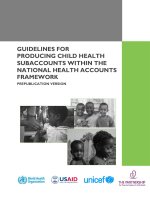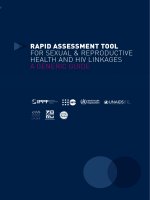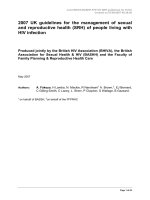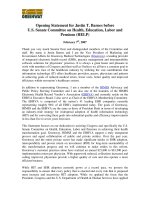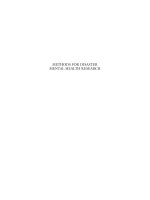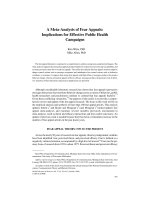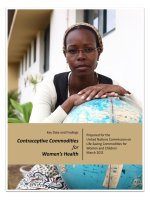Societal preferences for adjuvant melanoma health states: UK and Australia
Bạn đang xem bản rút gọn của tài liệu. Xem và tải ngay bản đầy đủ của tài liệu tại đây (746.13 KB, 8 trang )
Middleton et al. BMC Cancer (2017) 17:689
DOI 10.1186/s12885-017-3673-y
RESEARCH ARTICLE
Open Access
Societal preferences for adjuvant
melanoma health states: UK and Australia
Mark R. Middleton1, Michael B. Atkins2, Kaitlan Amos5, Peter Feng Wang3, Srividya Kotapati3, Javier Sabater4
and Kathleen Beusterien5*
Abstract
Background: No studies have measured preference-based utility weights for specific toxicities and outcomes
associated with approved and investigational adjuvant treatments for patients with resected high-risk melanoma.
Methods: A cross-sectional study was conducted in the United Kingdom and Australia to obtain utilities for 14
adjuvant melanoma health states. One-on-one interviews were conducted using standard gamble; utility weights
range from 0.0, dead, to 1.0, full health. Supplemental risk questions also were asked.
Results: Among 155 participants (52% male; mean age, 46 years) “adjuvant treatment no toxicities” (0.89) was most
preferred, followed by “induction treatment” (0.88), and “no treatment” (0.86). Participants least preferred “cancer
recurrence” (0.62); the utility for “cancer recurrence and 10-year survival with treatment” was 0.70. Disutilities for
grade 2 toxicities ranged from −0.06 for fatigue to −0.13 for hypophysitis. The mean maximum acceptable risk of a
life-threatening event ranged from 30% for a 6% increase in the chance of remaining cancer free over 3 years to
40% for an 18% increase; Australian respondents were willing to take higher risks.
Conclusion: Reproducible health utilities for adjuvant melanoma health states were obtained from the general
population in two countries. These utilities can be incorporated into treatment-specific cost-effectiveness
evaluations.
Background
Currently, 132,000 melanoma skin cancers occur globally each year [1]. Malignant melanoma is the ninth
most common cancer in Europe; in the United Kingdom, incidence rates are estimated to be the ninth highest among males in Europe and seventh highest among
females [2]. In Australia, the incidence is the highest in
the world due to the combination of high ultraviolet radiation, outdoor lifestyle, and a predominately Caucasian
population [3]. In earlier-stage melanoma, the treatment
of choice is surgical, and adjuvant therapy may be considered in patients with intermediate-risk melanoma [4].
Adjuvant melanoma therapies include high-dose interferon (IFN) α2b and low-dose pegylated-IFN [5]. More
recently the anti-CTLA-4 antibody, ipilimumab, has
been investigated in phase 3 trials [6] and received US
FDA approval for treatment of patients with resected
stage III melanoma in October 2015.
* Correspondence:
5
Outcomes Research Strategies in Health, Washington, DC 20008, USA
Full list of author information is available at the end of the article
To evaluate the cost-effectiveness of therapies, particularly for life-threatening conditions such as cancer, it is
useful to be able to assign cardinal utilities, or preference
weights, to potential health outcomes in order to calculate quality-adjusted life expectancy. Health states that
lend themselves to assignment of utility weights are
those that impact patient health-related quality of life. In
high-risk melanoma patients being considered for adjuvant therapy, such health states include treatment experience, toxicities, and relapse [7]. Consistent with the
National Institute for Health and Care Excellence recommendations, preferences should be derived using a
choice-based method, such as time trade-off or standard
gamble, which typically value health states relative to full
health and death. In addition, utilities ideally should be
based on the general population perspective [8].
The standard gamble approach has been implemented
in numerous studies in cancer [9–11]. Using this approach, a recent study focusing on health states associated with adjuvant IFN found that utilities for melanoma
recurrence were significantly lower than for all IFN
© The Author(s). 2017 Open Access This article is distributed under the terms of the Creative Commons Attribution 4.0
International License ( which permits unrestricted use, distribution, and
reproduction in any medium, provided you give appropriate credit to the original author(s) and the source, provide a link to
the Creative Commons license, and indicate if changes were made. The Creative Commons Public Domain Dedication waiver
( applies to the data made available in this article, unless otherwise stated.
Middleton et al. BMC Cancer (2017) 17:689
toxicity scenarios [9]. Another study used the standard
gamble approach to identify utility values for 18 prostate
cancer health states from the perspective of the general
population as well as patients with prostate cancer [10].
Preference studies in cancer also have examined factors
influencing treatment decision-making. A study using
standard gamble to assess outcomes in metastatic colorectal cancer found that patients who were older, stage
III versus IV and who had prior radiotherapy, lower educational attainment, and lower household income were
less willing to tolerate treatment-related adverse events
[11]. The humanistic impact, efficacy, and safety of treatment often are highlighted as the most important factors
influencing treatment decision making among patients
with cancer [12, 13].
Utility measurement in adjuvant melanoma to date
has primarily focused on outcomes associated with IFN
therapy [7, 14]. None have focused on adjuvant ipilimumab outcomes. As such, the objective of this study was
to obtain utility weights for key outcomes, including toxicities and relapse, associated with ipilimumab and IFN
in the adjuvant treatment of patients with high-risk
melanoma.
Methods
This was a cross-sectional study conducted in the
United Kingdom and Australia to obtain utilities for adjuvant melanoma health states among adult members of
the general public. Study participants were recruited
through advertising by a market research company.
One-on-one interviews were conducted with participants by trained interviewers using the standard gamble
technique. In standard gamble, the respondent identifies
the maximum risk of being dead that he or she is willing
to take to avoid being in a selected health state. Specifically, respondents imagine that they are in a specific
health state and can remain in that state or take a gamble that involves a chance (p) of achieving full health
with a corresponding chance (1 − p) of being dead. The
p probabilities are varied using a ping-pong approach,
converging on p = 50%, until the respondent is indifferent to the two options [15]. A prop was used in each
interview to help visualize the percentage risks. Study recruitment occurred from April through June, 2015. All
participants provided informed consent and received
compensation for their time. This study was approved
by Magil Institutional Review Board (Rockville, MD) and
complied with the tenets of the Declaration of Helsinki
(Additional file 1).
Utilities were obtained for health states that included
current health, five treatment-related states that included
adjuvant treatment with no toxicity, induction treatment, no treatment, cancer recurrence, and recurrence
with long term survival. The ‘long term survival’ state
Page 2 of 8
was developed based on findings showing a survival
benefit associated with ipilimumab over 10 years [16].
Nine treatment toxicity states were described in association with receiving adjuvant cancer treatment. The toxicity states included key toxicities associated with
ipilimumab (diarrhea, skin reaction/rash, hypophysitis),
IFN (flu-like syndrome with myalgia/arthralgia, fatigue,
depression), and nausea. The respective descriptions
were developed based on the definitions of grade two
events in the National Cancer Institute Common Toxicity Criteria for Cancer v4.0 [17]. To capture severe toxicities of any grade that result in an outpatient visit or
hospitalization, two additional health states were developed to reflect these outcomes. To establish the context
of the adjuvant treatment setting, all of the health states
except for those describing cancer recurrence begin
with: “You have undergone surgery and have had cancer
completely removed, but you still are at high risk of the
life-threatening cancer coming back.” “Melanoma” was
not specified to minimize biased responses based on perceptions of this cancer.
All health states were labeled with symbols to avoid
imposing a predetermined hierarchical order on the
states. The descriptions were developed in layperson
terms, and health states were refined with input from
two clinical experts and a pilot test with 10 individuals
from the general public (five in the United Kingdom and
five in Australia). After the standard gamble exercise,
the participants were asked three open-ended questions
about the maximum acceptable risk they were willing to
accept for a treatment with different levels of effectiveness. Specifically, they were asked: “If you had a lifethreatening cancer, what is the maximum risk of a lifethreatening event that you would be willing to accept to
take a treatment that would increase your chance of
remaining cancer free over 3 years by X%?” The three
questions included 6%, 12%, and 18% as the effectiveness
percentage. Finally, the respondents completed a form
with questions on demographics and perceptions about
health.
Analysis
The target sample size for this study was to recruit approximately 85 individuals from each country in an effort to have analyzable data for 75 in each country. It
was determined that 75 participants would be sufficient
to yield estimates with standard errors as low as 0.03
[18]. All data were reported using descriptive statistics
including means and frequencies, as applicable. For each
health state, the respective utility equaled the probability
p of full health at the point the respondent was indifferent to remaining in the health state and taking the gamble. Utility scores ranged from 0.0, reflecting being dead,
to 1.0, reflecting full health. Disutilities for each of the
Middleton et al. BMC Cancer (2017) 17:689
Page 3 of 8
versus UK participants agreed that “it would be better to
have cancer return after taking a treatment with
strong side effects than to have it return without taking treatment” (40% vs. 31%; p = 0.007). More UK
participants reported feeling downhearted and blue at
least a little of the time during the past month (67%
vs. 53%; p = 0.003).
toxicities were calculated by subtracting the utility for
“adjuvant treatment, no toxicity” from the utility of the
toxicity state. Statistical comparisons among subgroups
were performed using analysis of variance and Pearson
chi-square tests, as applicable; Tukey’s multiple comparison test was applied for comparisons across more than
two subgroups. Statistical significance was determined
based on a p-value of less than 0.05. SPSS (Version 22)
was used to conduct all statistical analyses.
Preference weights
Results
A total of 172 individuals participated in this research,
87 from the United Kingdom and 85 from Australia. Of
the 172 respondents, 17 (9.8%) were excluded because
they had at least three inconsistent pairs of standard
gamble utilities; these included a) the utility for adjuvant
treatment plus toxicity or severe toxicity was higher than
the utility for adjuvant treatment without toxicity or b)
the utility for cancer recurrence was higher than the
utility of adjuvant treatment without toxicity. Excluded
participants’ demographics did not differ from those of
included participants, except for gender, in which females were excluded more than males (77% vs. 48%;
p = 0.036). The total effective sample included 155 participants, 80 from the United Kingdom and 75 from
Australia, residing in 43 cities across these countries.
Table 1 shows demographic and clinical characteristics
for the study participants. The mean age was 46 ± 16 years,
and 52% were male. The country-specific samples were
closely matched according to the age and gender of the
target adult populations in the United Kingdom and
Australia, as reported in 2011 Census data [19, 20]. Although most respondents were Caucasian in both countries, more UK respondents were black (10% vs. 1%), and
more Australians were Asian (13% vs. 2%). More Australians attained a higher level of education with a university
or postgraduate degree (81% vs. 50%; p < 0.001) and were
working full or part time (76% vs. 50%; p = 0.005). In response to a question inquiring about overall health, more
Australian respondents reported being in “excellent” or
“very good” health versus UK respondents (71% vs. 48%;
p = 0.016). Similar percentages of participants reported
having no health conditions. More Australian participants
reported knowing someone with melanoma versus UK
participants (29% vs. 7%; p < 0.001).
In response to the items about health perceptions,
most participants (77%) reported that they would “rather
live a short time in good health than a long time in very
bad health.” However, most (86%) indicated that “if they
had a life-threatening disease, they would do whatever
to improve the chance of surviving,” and most (86%)
would “accept feeling lousy for a year if it meant having
a better chance of living longer.” Most (81%) reported
having someone to take care of them. More Australian
In Australia and the United Kingdom, utilities for
“current health” were 0.99 and 0.97, respectively. Figure 1
shows the mean standard gamble utilities for the
treatment-related states. “Adjuvant treatment no toxicities” (0.890) had the highest preference weight, followed
by “induction treatment” (0.878), and “no treatment”
(0.855). Whereas the Australian participants favored “adjuvant treatment no toxicities” (0.942) more than “no
treatment” (0.875), the UK participants rated these states
about the same (0.840 and 0.837 respectively). Participants in both the United Kingdom and Australia least
preferred “cancer recurrence” (0.581 and 0.662, respectively) among all of the health states. The state describing
cancer recurrence, but having a 10-year survival with
treatment (“long-term survival”) had higher utilities than
“cancer recurrence”; specifically, the utilities for “longterm survival” were 0.703 in the United Kingdom and
0.774 in Australia. Except for “no treatment,” the
treatment-related state utilities were significantly higher
(p < 0.05) among Australian respondents compared to
UK respondents. The toxicity disutilities, including grade
2 toxicities and severe toxicities leading to an outpatient
visit or hospitalization, are presented in Fig. 2; none differed significantly by country.
None of the standard gamble utility scores varied significantly by gender or race. Variations by age were not
observed with the exception of the “no treatment” state,
which was preferred more among those in the 18–39
age group compared to the 40–59 age group (0.914 vs
0.804; p = 0.005) (the mean utility for “no treatment” in
the 60+ age group was 0.844). A comparison of utilities
between those reporting “excellent” or “very good”
health versus those reporting “good,” “fair,” or “poor”
health in response to the question on overall health
showed the former group to have a higher mean
“current health” utility than the latter group (0.994 vs
0.959; p = 0.017). Otherwise, no other health state utilities differed significantly between these two groups. Individuals who completed college/university or above had
significantly higher utilities compared to those with secondary/sixth form/year 13 or lower levels for “adjuvant
treatment no toxicity,” “fatigue,” “diarrhea,” and “toxicity-outpatient.” Also, respondents knowing someone
with melanoma had higher utilities for all of the health
states versus those who did not know someone with
Middleton et al. BMC Cancer (2017) 17:689
Page 4 of 8
Table 1 Demographic characteristics
Characteristic
Overall
(N = 155)
UK
(n = 80)
Australia
(n = 75)
Age (±SD)
45.56 (±16.2)
46.1 (±17.8)
44.97 (±14.4)
Male
81 (52.3%)
40 (50%)
41 (54.7%)
Race
p value
0.66
0.56
0.008
White
120 (77.4%)
65 (81.3%)
55 (73.3%)
Black
9 (5.8%)
8 (10%)
1 (1.3%)
Indian
8 (5.2%)
3 (3.8%)
5 (6.7%)
Asian
12 (7.7%)
2 (2.5%)
10 (13.3%)
Other/ multiracial
5 (3.2%)
2 (2.5%)
4 (5.3%)
Employment
0.005
Full time
77 (49.7%)
34 (42.5%)
43 (57.3%)
Part time
21 (13.5%)
7 (8.8%)
14 (18.7%)
Retired
22 (14.2%)
15 (18.8%)
7 (9.3%)
Student
14 (9%)
11 (13.8%)
3 (4.0%)
Other
21 (13.5%)
13 (16.4%)
13 (10.6%)
1 (0.6%)
1 (1.3%)
0
Primary/third form/year 9
1 (0.6%)
0
1 (1.3%)
Secondary/sixth form/year 13
51 (32.9%)
39 (48.8%)
12 (16%)
University/college
80 (51.6%)
33 (41.3%)
47 (62.7%)
Postgraduate degree
21 (13.5%)
7 (8.8%)
14 (18.7%)
Excellent
31 (20%)
12 (15.0%)
19 (25.3%)
Very good
60 (38.7%)
26 (32.5%)
34 (45.3%)
Good
39 (25.2%)
22 (27.5%)
17 (22.7%)
Fair
17 (11%)
14 (17.5%)
3 (4.0%)
Poor
8 (5.2%)
6 (7.5%)
2 (2.7%)
None
65 (41.9%)
30 (37.5%)
35 (46.7%)
Arthritis
24 (15.5%)
16 (20%)
8 (10.7%)
Heart disease
5 (3.2%)
5 (6.3%)
0
Depression
22 (14.2%)
15 (18.8%)
7 (9.3%)
Diabetes
6 (3.9%)
4 (5%)
2 (2.7%)
a
Education
Primary/junior/year 6
<0.001
Overall health
0.016
Health conditions
GI problems
13 (8.4%)
6 (7.5%)
7 (9.3%)
Pain
25 (16.1%)
15 (18.8%)
10 (13.3%)
Respiratory disorder
23 (14.8%)
18 (22.5%)
5 (6.7%)
Other
21 (13.5%)
8 (10%)
13 (17.3%)
Experience with melanomaa
a
0.248b
<0.001c
Been diagnosed with melanoma
7 (4.5%)
4 (5.0%)
3 (4.0%)
Know someone with melanoma
28 (18.1%)
6 (7.5%)
22 (29.3%)
Missing data for 1 respondent in Australia
b
p-value for difference in None category
c
p-value for difference for category “know someone with melanoma”
Middleton et al. BMC Cancer (2017) 17:689
Page 5 of 8
Fig. 1 Mean standard gamble utilities for treatment-related health states. *p < 0.05 for differences between countries
melanoma (Table 2). The differences were significant for
“adjuvant treatment no toxicities,” “induction treatment
no toxicities,” “fatigue,” “rash,” “toxicity-outpatient,” and
“long term survival.”
Maximum acceptable risk
Figure 3 shows the mean maximum acceptable risk for
each of the efficacy estimates by participants overall and
by country. Overall, the mean maximum acceptable risk
of a life-threatening event ranged from 30% for a 6% increase in the chance of remaining cancer free over 3 years,
to 40% for an 18% increase. Australian respondents were
more willing to take higher risks than UK respondents by
approximately 9%; the difference was significant for an
18% increase in the chance of remaining cancer free
(45.4% ± 29.0 vs. 35.6% ± 29.5; p = 0.039).
Discussion
This study yielded general population utilities for adjuvant
melanoma treatment-related health states, including those
Fig. 2 Mean disutilities for toxicity states: overall population
associated with IFN and ipilimumab. Utilities are reported
for the United Kingdom, Australia, and the overall study
population. With respect to the toxicities evaluated, disutilities (negative values) were calculated, facilitating the application of these values to patients who may be experiencing
these effects, but may not currently be receiving adjuvant
treatment. The utilities from this study can be used to
quality-adjust life expectancy, as well as inform the evaluation of melanoma treatment outcomes in future studies.
The utilities obtained in this study are similar to those
obtained by Kilbridge et al. [7], who used standard gamble to obtain utility weights for adjuvant IFN health
states from patients with low-risk melanoma. Specifically, they obtained a mean utility for “IFN treatment
without side effects” of 0.92; in this study, “adjuvant
treatment without toxicity” had a mean utility of 0.89.
The mean utilities for “cancer recurrence” in the Kilbridge et al. study and in this study were 0.61 and 0.62,
respectively. Finally, “severe side effects” (that did not include hospitalization) had a mean utility of 0.81 in the
Middleton et al. BMC Cancer (2017) 17:689
Page 6 of 8
Table 2 Standard gamble scores by response to knowing someone with melanoma
Know someone with melanoma
(n = 28)
Do not know someone with melanoma
(n = 122)
p value
Current health
0.989 ± 0.04
0.978 ± 0.08
0.507
Adjuvant treatment no toxicities
0.952 ± 0.09
0.877 ± 0.16
0.001
Induction treatment
0.941 ± 0.08
0.865 ± 0.17
0.001
No treatment
0.895 ± 0.16
0.846 ± 0.20
0.222
Fatigue
0.896 ± 0.13
0.821 ± 0.18
0.019
Nausea
0.873 ± 0.15
0.800 ± 0.20
0.078
Rash
0.885 ± 0.16
0.800 ± 0.20
0.040
Flu
0.853 ± 0.17
0.805 ± 0.18
0.195
Diarrhea
0.851 ± 0.19
0.785 ± 0.21
0.127
Toxicity-outpatient
0.886 ± 0.14
0.764 ± 0.21
0.001
Depression
0.831 ± 0.22
0.768 ± 0.23
0.154
Hypophysitis
0.818 ± 0.17
0.742 ± 0.21
0.078
Long-term survival
0.843 ± 0.19
0.715 ± 0.22
0.003
Toxicity-hospital
0.791 ± 0.18
0.726 ± 0.21
0.133
Recurrence of cancer
0.673 ± 0.26
0.607 ± 0.25
0.215
Kilbridge et al. study; in this study, severe toxicity with
an outpatient visit had a mean utility of 0.78.
As may be expected, the utilities obtained for “adjuvant treatment-no toxicities” and “recurrence” were
higher in this study relative to comparable states in advanced melanoma reported by Beusterien et al. [21],
which used standard gamble to obtain utilities for advanced melanoma treatment health states from the general UK and Australian populations. Specifically, the
utilities for these states were approximately 0.10 points
higher than those for “treatment of advanced melanoma
with stable clinical response” and “recurrence of advanced melanoma,” respectively.
The disutilities for the toxicities, calculated by subtracting “adjuvant treatment no toxicity” from “adjuvant
Fig. 3 Risk-benefit tradeoff curve for UK, Australia, and overall
treatment plus toxicity,” were similar to the disutilities
found for the same toxicity states in the Beusterien et al.
[15] study. Specifically, the disutilities for the respective
grade 2 toxicities in this study ranged from −0.08
(“rash,” “nausea,” and “flu-like syndrome”) to −0.09
(“diarrhea”). In the Beusterien et al. study, disutilities
ranged from −0.06, for “skin reaction/rash” to −0.11 for
“flu-like syndrome.” Also, in this study, the mean disutilities for “severe toxicity-outpatient” and “severe toxicityhospital” were −0.11 and −0.16, respectively; in the Beusterien et al. study, the mean disutilities for these health
states were −0.13 and −0.17, respectively. Among the
toxicities in this study, hypophysitis was rated as worst.
This may have been attributable to the verbiage in the
health state description, which could be characterized as
Middleton et al. BMC Cancer (2017) 17:689
more severe than grade 2, as it referred to having headaches, blurred vision, and feeling sluggish.
Compared to the UK participants, the Australian participants reported higher preferences for all of the health
states than the UK participants, except for “no treatment.” The higher preferences observed among the Australian participants may be in part attributable to higher
familiarity with melanoma. Specifically, knowing someone with melanoma, which more often occurred among
Australian participants, was associated with higher preferences for the health states. These participants may
have higher preference for adjuvant treatment as well as
adjuvant treatment coupled with toxicities because they
have greater knowledge of the potentially devastating
impact of life-threatening cancer and are thus willing to
tolerate higher risks of side effects. This finding also is
consistent with previous research that found that patients and caregivers tended to assign higher utilities for
health states relative to the general population and noncaregivers, respectively [10, 22]. Age, gender, and perception of overall health largely were not associated with
health state preferences, except that, as may be expected,
those reporting “excellent” or “very good” health had
more favorable utilities for the “current health” state versus those in “good,” “fair,” or “poor” health.
As expected, when asked to identify the maximum risk
of a life-threatening side effect that was acceptable for a
treatment that would increase the chance of survival
over 3 years by 6%, 12%, or 18%, the study participants
reported higher risk acceptance as treatment effectiveness increased. In agreement with our findings, more
than 50% of low-risk melanoma patients found mildmoderate and severe IFN toxicity tolerable if accompanied by 4% and 10% improvements in 5-year survival [7].
As this study used a convenience sample of volunteers, it is unknown whether or not utilities among
non-volunteers may differ. Also, it is unknown whether
or not the magnitude of utility decrements for the toxicities was influenced by coupling the toxicities with
taking adjuvant treatment. Nevertheless, this coupling
more truly reflects reality. In addition, while our study
did not consider health states with multiple toxicities,
several studies have explored the estimation of utilities
given this scenario and recommend using a minimal
model in which joint-state utilities are predicted to be
equivalent to the utility of the worse health state [23,
24]. If one was to use this model to interpret the
current study findings, a patient receiving adjuvant
treatment (average utility = 0.89) experiencing both
grade 2 fatigue (average disutility = −0.06) and grade 2
depression (average utility = −0.11) would be assigned a
utility of 0.78 (0.89 minus 0.11). The disutility of depression was incorporated instead of fatigue because
the former has a lower utility.
Page 7 of 8
Conclusions
In summary, the findings from this study are consistent
with previous preference research in melanoma, and the
utilities obtained in this study may be used to qualityadjust life expectancy in adjuvant melanoma research.
Because the methodology in this study is consistent with
previous research in advanced melanoma, the utilities
from these studies have the potential to be used together
in research studies focusing on melanoma treatment
across disease stages.
Additional file
Additional file 1: Interview Script. (PDF 259 kb)
Abbreviations
CTLA-4: cytotoxic T-lymphocyte-associated protein 4; FDA: Food and Drug
Administration; GI: gastrointestinal; IFN: interferon; SD: standard deviation;
UK: United Kingdom; US: United States
Acknowledgements
The authors gratefully acknowledge Global Perspectives for their role in
study recruitment and for performing the interviews. Editorial assistance was
provided by Stephan Lindsey, PhD, and Cara Hunsberger at StemScientific,
an Ashfield Company, funded by Bristol-Myers Squibb.
Funding
This research was funded by Bristol-Myers Squibb (BMS). BMS helped to
identify the health states to include in this study, reviewed the study
protocol, assisted in interpretation of the findings, and provided comments
on draft versions of the manuscript.
Availability of data and materials
The dataset from this study is available from the corresponding author on
reasonable request.
Authors’ contributions
MM and MBA contributed to the identification and the descriptions of the
health states and interpretation of the findings and provided comments on
draft versions of the manuscript. KA and KB designed the study, developed
the study protocol, managed data collection, performed the analyses,
interpreted the findings, and developed the first draft of the manuscript.
PFW, SK, and JS helped to identify the health states to include in this study,
reviewed the study protocol, assisted in interpretation of the findings, and
provided comments on draft versions of the manuscript. All authors have
read and approved the final version of this manuscript.
Ethics approval and consent to participate
This study was approved by Magil Institutional Review Board (Rockville, MD)
and complied with the tenets of the Declaration of Helsinki. Written
informed consent was obtained from all study participants.
Consent for publication
Not applicable.
Competing interests
MM: Consulting or Advisory Role: Amgen, Bristol-Myers Squibb, Clovis, GlaxoSmithKline, Immunocore (uncompensated), Merck, Roche (all compensated);
Research Funding: Amgen, AstraZeneca, Bristol-Myers Squibb, Clovis, Eisai,
GlaxoSmithKline, Immunocore, Medimmune, Merck, Pfizer, Roche, Vertex;
Travel, Accommodations, Expenses: Merck, Roche. MBA: Consulting or Advisory Role: Amgen, Bristol-Myers Squibb, Caladrius, GlaxoSmithKline, Genentech
Roche, Merck, Nektar, Novartis, Pfizer. KA: Consulting role: Bristol-Myers
Squibb. PFW: Employment: Bristol-Myers Squibb. SK: Employment: BristolMyers Squibb; Stock or Other Ownership: Bristol-Myers Squibb; Research
Funding: Bristol-Myers Squibb; Travel, Accommodations, Expenses: Bristol-
Middleton et al. BMC Cancer (2017) 17:689
Myers Squibb. JS: Employment: Bristol-Myers Squibb; Stock or Other Ownership: Bristol-Myers Squibb; Research Funding: Bristol-Myers Squibb. KB: Consulting role: Bristol-Myers Squibb.
Publisher’s Note
Springer Nature remains neutral with regard to jurisdictional claims in
published maps and institutional affiliations.
Author details
1
University of Oxford Department of Oncology, Roosevelt Drive, Oxford OX3
7DQ, UK. 2Georgetown-Lombardi Comprehensive Cancer Ctr, 3970 Reservoir
Road, NW Research Building, Room E501, Washington, DC 20057, USA.
3
Bristol-Myers Squibb Co, 3401 Princeton Pike, Lawrenceville, NJ 08648, USA.
4
Bristol-Myers Squibb S.A. Quintanavides, 15, 28050 Madrid, Spain.
5
Outcomes Research Strategies in Health, Washington, DC 20008, USA.
Received: 17 May 2016 Accepted: 5 October 2017
References
1. World Health Organization. />index1.html. Accessed 09 Dec 2015.
2. Cancer Research UK. />cancer-statistics/statistics-by-cancer-type/skin-cancer/incidence#headingSeven. Accessed 28 Sept 2015.
3. Baade PD, Royston P, Youl PH, Weinstock MA, Geller A, Aitken JF. Prognostic
survival model for people diagnosed with invasive cutaneous melanoma.
BMC Cancer. 2015;15:27.
4. Garbe C, Peris K, Hauschild, et al. Diagnosis and treatment of melanoma.
European consensus-based interdisciplinary guideline-update 2012. Eur J
Cancer. 2012;48:2375–90.
5. Grob JJ, Jouary T, Dréno B, et al. Adjuvant therapy with pegylated interferon
alfa-2b (36 months) versus low-dose interferon alfa-2b (18 months) in
melanoma patients without macrometastatic nodes: an open-label,
randomised, phase 3 European Association for Dermato-Oncology (EADO)
study. Eur J Cancer. 2013;49(1):166–74.
6. Eggermont AM, Chiarion-Sileni V, Grob JJ, et al. Adjuvant ipilimumab versus
placebo after complete resection of high-risk stage III melanoma (EORTC
18071): a randomised, double-blind, phase 3 trial. Lancet Oncol. 2015;16(5):
522–30.
7. Kilbridge KL, Weeks JC, Sober AJ, Haluska FG, Slingluff CL, Atkins MB, Sock
DE, Kirkwood JM, Nease RF. Patient preferences for adjuvant interferon alfa2b treatment. J Clin Oncol. 2001;19(3):812–23.
8. National Institute for Health and Care Excellence, 2013 http://publications.
nice.org.uk/guide-to-the-methods-of-technology-appraisal-2013-pmg9.
Accessed 01 July 2014.
9. Kaehler KC, Blome C, Forschner A, et al. Preferences of German melanoma
patients for interferon (IFN) α-2b toxicities (the DeCOG "GERMELATOX
survey") versus melanoma recurrence to quantify patients' relative values for
adjuvant therapy. Medicine (Baltimore). 2016;95(46):e5375.
10. Gries KS, Regier DA, Ramsey SD, Patrick DL. Utility estimates of diseasespecific health states in prostate cancer from three different perspectives.
Appl Health Econ Health Policy. 2017;15(3):375–84.
11. Fu AZ, Graves KD, Jensen RE, Marshall JL, Formoso M, Potosky AL. Patient
preference and decision-making for initiating metastatic colorectal cancer
medical treatment. J Cancer Res Clin Oncol. 2016;142(3):699–706.
12. Burton M, Kilner K, Wyld L, Lifford KJ, Gordon F, Allison A, Reed M, Collins
KA. Information needs and decision making preferences of older women
offered a choice between surgery and primary endocrine therapy for early
breast cancer. Psychooncology. 2017 Mar 23; doi: 10.1002/pon.4429.
13. Vaz-Luis I, O'Neill A, Sepucha K, Miller KD, Baker E, Dang CT, Northfelt DW,
Winer EP, Sledge GW, Schneider B, Partridge AH. Survival benefit needed to
undergo chemotherapy: patient and physician preferences. Cancer. 2017
Mar 21; doi: 10.1002/cncr.30671.
14. Dixon S, Walters SJ, Turner I, Hancock BW. Quality of life and costeffectiveness of interferon alpha in malignant melanoma: results from
randomized trial. Br J Cancer. 2006;94:492–8.
15. Torrance GW. Measurement of health state utilities for economic appraisal. J
Health Econ. 1986;5c:1–30.
Page 8 of 8
16. Schadendorf D, Hodi FS, et al. Pooled analysis of long-term survival data
from phase III trials of ipilimumab in unresectable or metastatic melanoma.
J Clin Oncol. 2014;56:2736.
17. National Cancer Institute. />electronic_applications/ctc.htm. Accessed 10 Mar 2015.
18. Hulley SB, Cummings SR. Appendix 13D in designing clinical research: an
epidemiological approach. Baltimore, MD: Williams & Wilkins; 1998.
19. Office for National Statistics. />census/2011/index.html. Accessed 15 Mar 2015.
20. Australian Bureau of Statistics. />censushome.nsf/home/Census?opendocument# from-banner=GT. Accessed
15 Mar 2015.
21. Beusterien KM, Szabo SM, Kotapati S, et al. Societal preference values for
advanced melanoma health states in the United Kingdom and Australia. Br
J Cancer. 2009;101(3):387–9.
22. Matza LS, Boye KS, Feeny DH, et al. Impact of caregiver and parenting status
on time trade-off and standard gamble utility scores for health state
description. Health Quality Life Outcomes. 2014;12:48.
23. Dale W, Basu A, Elstein A, Meltzer D. Predicting utility ratings for joint health
states from single health states in prostate cancer: empirical testing of 3
alternative theories. Med Decis Mak. 2002;28:102–12.
24. Fu AZ, Kattan MW. Utilities should not be multiplied: evidence from the
preference-based scores in the United States. Med Care. 2008;46:984–90.
Submit your next manuscript to BioMed Central
and we will help you at every step:
• We accept pre-submission inquiries
• Our selector tool helps you to find the most relevant journal
• We provide round the clock customer support
• Convenient online submission
• Thorough peer review
• Inclusion in PubMed and all major indexing services
• Maximum visibility for your research
Submit your manuscript at
www.biomedcentral.com/submit
